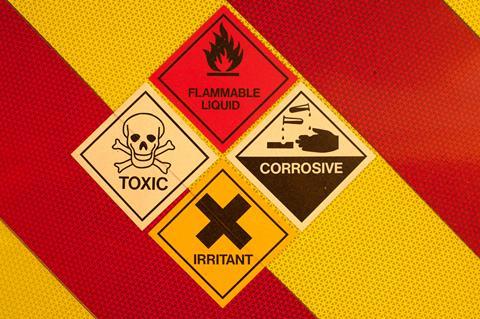The decade-long process to register all chemicals used in Europe has concluded. Nina Notman takes stock of progress and looks to the next steps for chemical legislation in the region
31 May 2018 was a landmark moment in the history of the European Chemicals Agency (Echa): the end of a monumental effort to register all chemicals produced and imported into the EU and EEA (European Economic Area) for the first time.
Over the past decade, the chemical industry has collected data on how over 21,500 chemicals impact on human health and the environment, and submitted it to Echa for storing in the world’s largest and most comprehensive, open chemicals database. Echa and the EU regulation that it was set up to manage – Reach (Registration, evaluation, authorisation and restriction of chemicals) – are now widely regarded as global role models for chemical safety.
Prior to Reach, chemical regulation in Europe was a mishmash of legislations with the responsibility for chemical safety – and the costs of checking – falling on the authorities. Large information gaps existed for many chemicals, particularly those manufactured for many decades. Reach was a paradigm shift: to sell a chemical in Europe it is now necessary to prove that it is safe, and the responsibility and cost of collecting the necessary data now rests squarely on the shoulders of the companies that manufacture or import it. It’s therefore unsurprising that implementing Reach has not been without its controversies.
Reach in numbers
Echa started the registration process on 1 June 2008, with companies required to inform it within six months of any chemicals they intended to request permission to manufacture or import. There have been three Reach deadlines since then: 2010 to register all chemicals produced at a rate of more than 1000 tonnes per year; 2013 to register middle (100–1000) tonnage chemicals; and 30 May 2018 for small-volume chemicals (1–100 tonnes per year).

The 2018 deadline was the biggest one, with around three times more registrations received than for either of the two previous higher-tonnage deadlines. Echa reported that as of 31 May 2018, it had received 88,319 registration dossiers across all three deadlines. Of which, by that date, 82,874 had been checked and granted the registration numbers required to sell them in Europe. The remaining 5445 were due to be processed by 31 August 2018.
This doesn’t mean that there are over 80,000 different chemicals sale in Europe. That figure, as of the 31 May 2018, was 21,551. ‘On average you have four companies producing each substance that is on the European market,’ explains Bjorn Hansen, Echa’s executive director.
In total, 13,500 companies registered chemicals with Echa. 18% of registrations come from micro, small or medium-sized companies (SMEs) and 82% from large chemical manufacturers. 39% of all registrations were from manufacturers based in EU and EEA countries; Germany contributed 25% of these, followed by the UK (14%) and France (10%). The remainder came from companies located outside of Reach’s jurisdiction.
The total financial cost to the global chemical industry for meeting Reach obligations has not yet been revealed. A European Commission (EC) study published in March 2018 stated that submissions for the 2010 and 2013 deadlines alone had cost industry €2.3–2.6 billion. Hansen expects the final cost to companies to be around €10 billion.
This figure is approximately double initial estimates. Spiralling costs have been blamed on data-sharing requirements, mandated after cost estimates were made. ‘This data-sharing obligation means that although we may have four registrations for a chemical, you only have one registration for the animal data, and the other three are required to share the costs,’ Hansen says. Sharing the cost of tests should have reduced costs to individual companies, but that wasn’t the case. ‘Since EU competitiveness laws are so strong, lawyers need to be involved to be sure that companies share the costs without sharing any market information,’ says Hansen. ‘We have evidence that having lawyers involved through the forced data sharing has significantly increased the cost.’
Reaching its potential
The primary goal of Reach was to improve the protection of human health and the environment from the risks that can be posed by chemicals. This has two parts: ensuring all chemicals are used as safely as possible, and pushing companies towards developing less-hazardous alternatives to any chemicals with high safety concerns.
‘There is clearly much more exchange of information on the safe handling of chemicals in the supply chain than ever before,’ says Erwin Annys, Reach director at the trade association Cefic (European Chemical Industry Council). Concerns remain about how this information is provided. ‘We have received feedback from clients that expansion of documents [to meet Reach regulations] has also reduced the usability,’ explains a spokesperson for German chemicals giant BASF. ‘This indicates that a balance still needs to be found. The communication should not only be viewed from the perspective of what a registrant can deliver, but more from the perspective of what a customer really needs and what they can digest.’
Some of the problem here is the lack of a standard design for parts of these documents, explains Francis Trudeau, product manager at global consulting firm Sphera. ‘The safety data sheets are PDFs and the format and shape of the information really changes, which makes machine-to-machine data transfer impossible,’ he says. A standard format was eventually put forward – by Cefic – but because its use is optional, it hasn’t yet been widely adopted.
Overall, however, it’s safe to say that manufacturers of chemicals sharing more information on their safe use with those that purchase and use them has improved chemical safety throughout the supply chain in Europe. Other countries have also followed the European lead in terms of resetting their chemical inventory, with South Korea and Turkey both introducing Reach-like regulations.

But, whether Reach has truly pushed innovation towards less hazardous chemical alternatives is a more contentious issue. ‘Reach creates a very clear legal framework for which chemicals we like on the European market, and which we don’t. And there’s quite some evidence with the Reach framework that companies are moving over to safer alternatives,’ says Hansen. In its March 2018 report, for example, the EC cited that under Reach, the sale of 43 chemicals that can have serious effects on human health and the environment (known as substances of very high concern) had been identified and placed on an ‘authorisation list’. Companies must now be granted permission to use these particular chemicals, and their use is to be gradually phased out as suitable alternatives become available.
Silvia Segna, Reach executive with the UK trade association Chemical Industries Association (CIA), agrees that the regulation has led to the reduction of the use of some substances of very high concern – but only in cases where there was already an alternative in existence. ‘In some cases, substances have been replaced with others without the need to invest in innovation,’ she says. In instances where suitable, safer alternatives are not available already, Segna believes Reach has had a negative effect. ‘Funds within the companies have been diverted into compliance rather than investing in innovation.’
Ahead of the pack?
The second overarching objective of Reach was to enhance the competitiveness of the EU chemicals industry. Progress here has been difficult to measure. ‘There’s very little evidence showing that Reach is bringing a competitive advantage, but there’s also no evidence showing it’s not,’ says Echa’s Hansen.
Cefic’s Annys agrees that it is impossible to quantify Reach’s impact especially against the backdrop of rapid growth in the Chinese chemical industry over the past decade. ‘But at least there is a level playing field,’ he explains. ‘Everyone who wants to produce chemicals outside the EU, and import them into the EU, is confronted with the same costs to Reach.’
EU companies can feel that they are at a competitive disadvantage
Unsurprisingly, therefore, trade associations outside of Europe have voiced Reach-related frustrations frequently over the past decade. ‘We are aware of companies that were supplying materials into the EU from US-based production that, because of Reach, have chosen to move production into the EU to avoid the need to register [as importers],’ says Robert Helminiak, head of government relations at the US-based Society of Chemical Manufacturers and Affiliates (Socma). ‘In other instances, where US-based suppliers were unwilling or unable to support their Reach needs, companies have switched to buying EU-based components.’
There is one exception to this level playing field ‘rule’, concerning substances of very high concern, explains the CIA’s Segna. ‘Articles that contain chemicals, whose use is subject to authorisation in Europe, can be imported into the EU without the need for an authorisation. However, in order to produce the article in the EU using that substance, an authorisation would be needed,’ she says. ‘EU companies feel that they are at a competitive disadvantage here because authorisation is very expensive. This is something that has been raised by industry many times and the EC has said they are considering what they could do to address this problem.’
A focus on rule enforcement
With the registration deadlines now in the past, Echa has said it will now turn its attention to checking companies have stuck to rules concerning intermediates. A year-long enforcement project will run in 2019. ‘In Reach we have two types of chemicals: normal chemicals and intermediates. Intermediates are only used upstream for the very specific purpose of creating other chemicals and therefore under certain conditions we have lower information requirements for these,’ explains Hansen. He adds that they will be checking that all chemicals on the market above a tonne have been registered, and whether they’ve been registered as the right type.
A previous Echa enforcement effort that focused on company-size declarations found a significant amount of rule bending. SMEs benefit from an up to 95% reduction in registration fees. The first two (2010 and 2013) deadlines saw 32% of dossiers claiming SME fee reductions: only 18% were found to actually be entitled to these. It is not Echa, however, who must decide how to punish wrong-doers – that falls to individual member states’ enforcement agencies.

In the UK, there are a number of different agencies with chemical regulation in their remit including the Health and Safety Executive (HSE) and the Environment Agencies. ‘There are a number of options open to HSE if it is appropriate to take enforcement action’ against a chemical manufacturer, explains HSE inspector Mike Potts. These include issuing legal notices requiring companies to comply with regulations. ‘Prosecution [is also possible] if it is in the public interest and we have the necessary evidence,’ he adds. ‘There have not yet been any prosecutions in the UK for Reach registration-related offences. A considerable number of notices have been served, however.’
The European chemical industry has voiced concerns about the ‘randomness’ of the enforcement process so far. ‘We find it extremely important that, now all existing substances should be registered under Reach, authorities now enforce it in a decent way so that no substance, mixture or article is coming into the EU which is not compliant with the Reach regulations,’ says Annys. If this is not done, he explains, companies that do comply are at a competitive disadvantage.
An evolving landscape
The Echa database, while now theoretically complete, will not be static. Chemical companies are required to keep all information held there up to date. ‘They have the obligation to horizon-scan scientific developments on the chemicals they supply, and when they see something which requires a change in classification or labelling, then they must update their safety data sheet and registration,’ explains Hansen. ‘That trigger is clear – what is more complicated to enforce is how much effort does a manufacturer or supplier need to put into following new information coming out of scientific research. What we are seeing is that they don’t update as much as we would theoretically like.’
UK companies need to start considering who might represent them in the EU post-Brexit
New chemicals will also continue to be added. ‘From June 1st onwards, before companies are allowed to put the substance on the market they have to tell Echa: “I intend to manufacture or import this substance,”’ Hansen explains. ‘If the substance has already been registered then we put that company into contact with all those companies who have already registered it as that new registrant has an obligation to share the costs of the original data collection.’
A much bigger change, however, is on the horizon for Echa and its database: Brexit. As mentioned above, 14% of all registrations from EU and EEA-based manufacturers come from UK companies. If – on 29 March 2019 – the UK leaves the EU with no transition deal these registrations will be removed from the database. Reach registrations would not be permitted in a UK name any more, explains the CIA’s Segna. This means ‘UK companies need to start considering who might represent them in the EU post-Brexit.’
Echa is already equipping itself for this eventuality. ‘We’re preparing for one scenario only, and that is that the UK leaves the union with no transition deal,’ says Hansen. This includes making changes to computer systems to ensure no UK access to data post-Brexit, and removing UK advisors from all Echa committees. ‘UK government experts play an active role in many of our committees, and we are phasing out the work that they do, so that on March 30th next year none of our work will be interrupted.’
In March 2018, UK prime minister Theresa May stated that the UK may seek associate membership to Echa – a suggestion welcomed by chemical trade associations. ‘We believe that the best solution, both for industry in the UK and in the EU27 [the remaining countries], as well as for the authorities, again, both in the UK and in EU27, is that the UK remains active within Echa,’ says Annys. This proposed bespoke agreement has some precedent. Countries inside the EEA but not the EU, namely Norway, Iceland and Liechtenstein, are part of Reach – although they don’t have the same voting rights as EU members. Switzerland, while not participating in Reach, does follow EU regulations for biocides.
It’s hard for chemical companies to prepare for a post-Brexit world without any details. And chemical legislation is just one on a long list of Brexit-related headaches with which the UK and EU27 governments are currently confronted. It is hoped more clarity will be available for the chemical industry in mid-October after the next EU summit – the viewed deadline for setting out the terms of the UK–EU divorce. ‘We will have a much better idea of what the world will look like in end of March 2019,’ says Annys hopefully.
Nina Notman is science writer based in Salisbury, UK













No comments yet